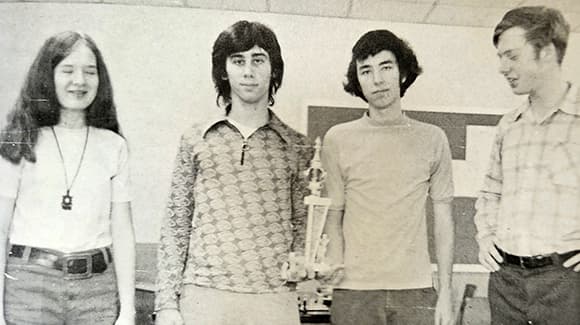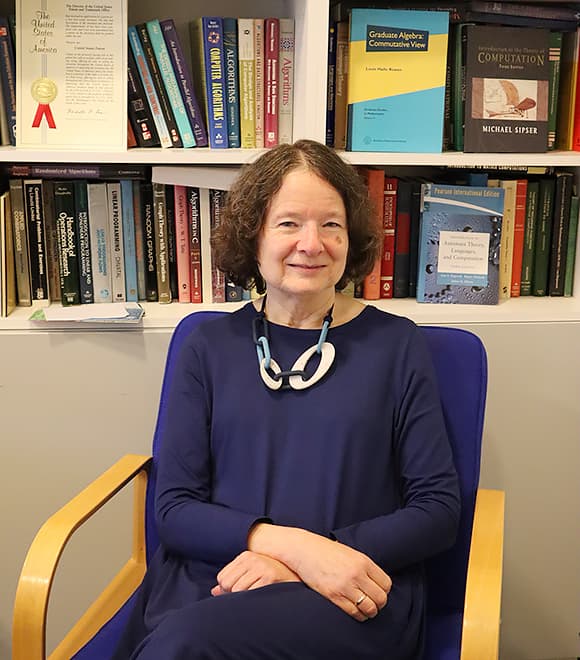
You Lost to the Girl?!
A Portrait of Joan Boyar, Recently Retired Professor in Computer Science at IMADA.
This interview with Joan unfolds in one of the department’s iconic upper floor offices. Surrounded by shelves stacked with books, a cozy chair in the corner, a diploma of a patent, and pictures of grandchildren, her office is a testament to a career and personal life both fruitful and fulfilling.
Joan Boyar, part of Department of Mathematics and Computer Science (IMADA) since 1991, sits amidst this collection of her life’s work. Despite her global academic tenure and her roots in America, Joan, now a dual citizen, is undeniably a part of the original “IMADA family”. It’s difficult for many to see the place without her.
– It was time to do more of what I love: Meaning pure research, and less of what I don’t love – meaning administration, Joan explains with a warm twinkle in her blue eyes. This transition fortunately marks not an end but a transformation, as Joan steps into the role of Emerita, a title she notes with a mix of pride and irony.
– I was the first female associate professor and the first female professor in this department. And I’ll be the first Professor Emerita at the Faculty of Science at SDU.
And being the first woman to do something is not uncommon to Joan. It’s sort of been a theme of her professional life.
From Psychology to Computer Science – Welcome “John Boyar”
When asked why she became a researcher, Joan reflects on an essential moment in 8th grade, spurred by a film from The National Reactor Testing Station, close to where she lived then:
– In the film, there was a woman scientist in a white lab coat. And suddenly I realized that this too was an option for girls.
This revelation set Joan on a path that merged her talents in math with her ambitions in science, though not without its detours and discoveries.
Even though Joan mostly had interests in mathematics, natural sciences, and engineering at that time in the early 70s, pursuing psychology seemed like the better and more solid choice for a young woman – or at least according to my father, Joan adds.
But during her psychology studies, and even though she liked the field, she found herself yearning for more rigorous scientific methodology:
– In my first year, I found myself involved in a research project that offered undergraduates the opportunity to collaborate with a PhD student on an experiment. Our small group was tasked with conducting our own experiment, too, but at some point, it was decided – due to time constraints or other reasons – that we would proceed without a control group. This decision left me feeling unsettled and questioning the validity of our experiment without this fundamental component, Joan explains.
Prompted by this experience and her inherent ability in mathematics, she opted to pursue a second major in math while at the University of Virginia:
– I liked the idea of doing something where a large part of it was thinking and solving problems, Joan says.
This journey was, however, not just about academic curiosity but also about navigating the subtleties of gender discrimination. During the last year on her second major, Mathematics (now at the University of Chicago), Computer Science caught her eye, after enrolling in several logic courses. These courses piqued her interest in recursion theory, automata theory, NP completeness, and complexity theory—the latter three areas also being within Computer Science.
This experience made her consider pursuing these topics further in graduate school, either in mathematics or computer science. And after much deliberation and having sent inquiries to graduate departments in both fields, she engaged in discussions with some female graduate students in mathematics at her institution. They shared insights into the subtle yet present discrimination within the field.
– This was further illustrated by an experience I had with a math department in Wisconsin, which addressed me as John Boyar in their response – apparently, they thought that the inquiry must have been from a male. This last experience convinced me that I would feel more comfortable as a woman in Computer Science – simply because it was considered more modern, and so I decided to pursue graduate studies in Computer Science, Joan concludes.
The Chess Club
Joan’s first encounter with being the first female goes back to her high school years. She was both in the chess club and named valedictorian. Simply put: A very smart and intelligent young woman, who was going places. And this was quite unusual.

– No, I was not a cheerleader, Joan replies with a laugh to the joking question.
– I used to be in the chess club – and I enjoyed that for some time, until I began to feel sorry for the boys.
At that time, back in the early 70s, Joan went to a high school in southern Virginia, which was very conservative. And her club played against all other teams from the other schools in the district:
– There was no other girl on any of the teams. It was rather traumatic for me because I won more than I lost. My team ended up winning the whole district. And whenever I won a match, it was very embarrassing for the poor boy that sat across the chessboard. His friends would ask him incredulously, “You lost to the girl?!” At some point, I could see that me winning over the boys was really hard on them. It was not a nice feeling, Joan explains.
Even though Joan did not like winning over the boys and eventually stopped playing chess competitively, she did not let the awkward feeling of being the first female stop her in her academic journey.
If You’re Under 25 Percent -–You End Up Feeling Like You’re a Minority
At IMADA back in the days, there were not many women at all – and Joan arrived again, one of the few and first, and slowly but surely helped start to change the culture towards a more woman-friendly atmosphere. Through hard work, academic accomplishments, and her steady and calm personality, she earned her respect:
– Though in the beginning – it was not easy for the few female students in computer science or Datateknologi. Female students would enter a TA’s office at the Maersk Institute, and there would be pornographic calendars on the walls, Joan says and continues:
– Lene Monrad Favrholdt was one of the first students who came to meetings I held for female students in computer science or Datateknologi. Later, she and I began to host these meetings together, just for the female computer science students at IMADA, giving them a forum where they could talk openly about their experiences.
”Joan cares for the students she is not advising: As an example, for 25 years or more, she has consistently, once or twice a year, organized social meetings for female CS students to give them the opportunity to get to know each other, across sections and across years, and to “check up on them” to see if there is anything we can help with.
Today there is a very different culture at SDU, though there is still room for improvement.
– No Playboy calendars on the walls, Joan says and laughs, and continues, I have read somewhere that if your type of gender/age/color, etc., are under 25% in a group, then you feel like a minority. Though in general, I think we have a fair share of women at IMADA – and that’s great – at Computer Science alone, we are still lacking girls, here there are not much more than 10% female students, and so they still need to have a special forum, in order to feel heard. We still have a way to go, Joan adds.

Teacher and Researcher: Patent and Dreams
Joan’s move to Denmark was somewhat influenced by a desire for a societal model that valued care for its people over the rugged individualism of her American upbringing:
– In DK, at that time, this country was better at taking care of people. I did not have to feel guilty so much for being fortunate. No homeless people on the streets, no beggars. Though this is a little different today, I still feel like Denmark is nicer and more oriented towards equality for every income group, than the US, says Joan.
However, it was also the academic environment that naturally had a pull. In the field of cryptology, her contributions have been diverse, garnering most of her citations. This is especially true of her work on developing techniques to create compact circuits, driven by cryptographic requirements.
Along with René Peralta from NIST (National Institute for Standards and Technology), she decided to apply their methods to a then relatively new cryptosystem known as AES (Advanced Encryption Standard). A challenging component of AES is the S-box, which is critical for its encryption process. Utilizing their techniques, they successfully designed multiple circuits specifically for the S-box, demonstrating the effectiveness of their approaches.

René and Joan hold a U.S. patent together. The unique aspect of this patent is that there never was any possibility for Joan to earn any money based on it because René was employed by NIST. Given NIST’s role in standardizing AES, it was imperative that none of their employees, including René, benefit financially from the patent. When the University of Southern Denmark (SDU) showed interest, NIST graciously assumed responsibility, covering all legal fees and management to ensure the patent remained non-profitable. Essentially, they transformed it into an open-source asset, precluding any potential for personal income from it. This arrangement underscores that the goal was never financial gain, but rather contributing to the field in a meaningful way.
The application of their work is now extending into the field of quantum computing. Researchers are beginning to design quantum circuits and, in doing so, are drawing inspiration from conventional circuit design principles. Consequently, Joan’s articles, including those not directly related to AES but to circuit complexity in general, are being referenced. This cross-disciplinary interest highlights the relevance of her contributions beyond traditional computing and showcases their applicability in the emerging field of quantum technology.
Recently, Joan has worked mostly in the area of online algorithms, including alternative measures for the quality of these algorithms, online algorithms with advice, and online algorithms with predictions. She gave an invited talk on online algorithms with predictions at the 48th International Symposium on Mathematical Foundations of Computer Science, in 2023.
Though holding a patent is a large accomplishment seen from the outside, this is not what Joan is most proud of:
– Professionally, I take great pride in the accomplishments of my PhD students, many of whom have achieved significant success. Among them, Lene Monrad Favrholdt and Rolf Fagerberg stand out as exemplary students under my guidance (both Professors at IMADA now). There are others, including Sanne Wøhlk (Professor at Aarhus University), who have also excelled in their academic and professional pursuits. Overall, I have had the privilege of mentoring 12 PhD students (plus two more currently), each of whom has contributed to my sense of achievement in this field, Joan adds.
And so, Joan loves to teach but she naturally also likes to do research:
– When I was young, I wanted to become a teacher or a woman scientist – I guess I ended up being both, Joan says and smiles.
Family and IMADA-Family
As we discuss her personal life, Joan shares glimpses into her world beyond academia. Married to Kim Skak Larsen, who is also a Professor at IMADA, and with whom she shares a daughter and two grandchildren, Joan’s life is filled with the warmth of family, the intellectual stimulation of book and bridge clubs, and the simple joys of sudoku and walks and keeping healthy with aerobics at least once a week.

Joan and Kim with their daughter Marianne, while on sabbatical at the University of Toronto, 2002.
Reflecting on her career, Joan’s achievements are not just inscribed in the archives of IMADA’s history, but also in the countless students she inspired, the research she drove forward, and the barriers she broke. As Joan Boyar transitions into her role as Emerita, she leaves behind a strong legacy.
”Joan was always extremely meticulous, almost painfully honest – guided by very clear and unfailing values. With her quiet but uncompromising way, her sharp mind, her hard work, even in the face of serious illness, her brilliant science, her expectation on others around her, not least me, to act on as high standards as she does herself, she has taught me – and many of us – a lot about what this place should be about. And I see it as a part of her ever-lasting commitment to making IMADA a good place to be, a counterweight to all the nonsense and fleeting insignificant matters that over the years have blown in from above – much of it from me – she has made a huge effort and investment in steering our department, always keeping focus on what is important. I would like to say thank you for this, for all she has given to us and to IMADA over the years. I have been very proud of having her as a professor here at the department. Working with her has been a great pleasure and a privilege. I hope that she will have many good years in good health as Professor Emerita here, being able and allowed to concentrate on research without disturbances.
“You lost to the girl?!” may have been an incredulous question posed in the past, but for Joan Boyar, it is a statement of triumph over the stereotypes and limitations placed upon her because of the time she grew up in.
In her story, we find not only the portrait of a pioneer but also a blueprint for future female scientists to dream, dare, and discover without bounds.

Meet the researcher
Joan Boyar is a Professor Emerita of Computer Science in the Department of Mathematics and Computer Science at the Faculty of Science, SDU. Joan Boyar’s primary research interests are online algorithms, combinatorial optimization, cryptology, Boolean functions, data structures, and computational complexity.